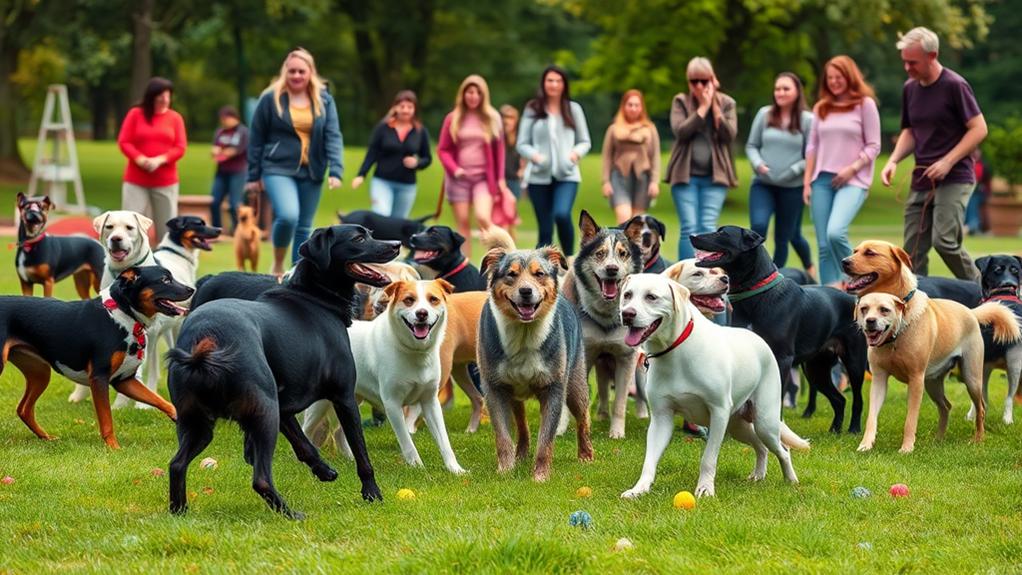Effective dog training uses behavior modification techniques to reshape unwanted behaviors. Start by recognizing triggers that prompt negative actions and utilize positive reinforcement to reward desired behaviors. Establish consistent commands across your household to reduce confusion. Address common issues, like excessive barking or jumping, by teaching alternative actions. Regular physical and mental exercise keeps your dog engaged and helps prevent issues like separation anxiety. Guarantee socialization with new people and environments occurs gradually. Track your progress and adjust techniques as needed to strengthen your bond. You'll discover even more strategies to enhance your training experience.
Understanding Behavior Modification
Understanding behavior modification in dogs involves recognizing how their actions are influenced by their environment and experiences. You need to pay attention to the triggers that prompt certain behaviors, whether they're positive or negative. For example, when your dog barks at strangers, it's vital to identify what's causing that reaction. Is it fear, excitement, or something else?
By observing your dog's body language and reactions, you'll gain insights into their emotional state. This helps you develop strategies to modify unwanted behaviors effectively. Timing is pivotal, so be consistent in your responses to their actions. When you notice a behavior you want to change, act promptly to redirect their focus.
Utilizing environmental changes can also aid in behavior modification. For instance, if your dog tends to chew on furniture, consider providing appropriate chew toys and limiting access to tempting items. Remember, every interaction shapes their understanding of acceptable behavior. You can create a positive learning environment by being aware of your dog's needs and the situations they encounter. This approach lays the foundation for successful training and fosters a better bond between you and your furry friend.
The Importance of Positive Reinforcement

Positive reinforcement is a powerful tool in dog training that encourages desirable behaviors by rewarding them. When you use this technique, you create a positive association in your dog's mind, making them more likely to repeat the behavior. For instance, if your dog sits on command and you offer a treat or praise, they'll learn that sitting leads to something enjoyable.
One of the key benefits of positive reinforcement is that it builds a strong bond between you and your dog. Your pup will start to trust you more, knowing that good behavior results in rewards. This creates a positive training environment, where your dog feels motivated and engaged.
Additionally, positive reinforcement fosters a willingness to learn. When dogs receive rewards, they're more enthusiastic to try new commands and tricks. It is crucial to be consistent in your approach; the more regularly you reward desired behaviors, the quicker your dog will understand what you expect.
Identifying Common Behavioral Issues
Every dog owner will likely encounter common behavioral issues at some point. Recognizing these issues early can help you implement effective training strategies. Pay attention to your dog's behavior and look for signs that something may be off. Here are some common behavioral problems you might notice:
- Excessive barking: Your dog may bark at anything and everything, which can become disruptive.
- Chewing: Destructive chewing can occur when dogs are bored or anxious.
- Jumping: Dogs often jump on people out of excitement, but it can be overwhelming for guests.
- House soiling: This can indicate a lack of proper training or a medical issue.
- Aggression: Aggressive behavior towards other dogs or people can stem from fear or territorial instincts.
Identifying these issues early on allows you to address them effectively. It is crucial to understand the root cause of each behavior since this will guide your training approach. By staying observant and proactive, you'll set the foundation for a well-behaved dog and a harmonious home.
Establishing Consistent Commands

Establishing consistent commands is essential for effective dog training, as it helps your dog understand what you expect from them. When you use the same words and tone for commands, your dog will learn more quickly and respond more reliably. Consistency in your commands decreases confusion and reinforces positive behavior.
Here's a simple guide to help you establish consistent commands:
| Command | Example Phrase |
|---|---|
| Sit | "Sit" |
| Stay | "Stay" |
| Come | "Come here" |
Make sure everyone in your household uses the same commands to avoid mixed signals. For instance, if one person says "down" while another says "get down," your dog may struggle to grasp what you want. It's also helpful to keep your commands short and clear. Avoid using phrases that are too long or complicated.
Techniques for Reducing Barking

Barking is a natural behavior for dogs, but excessive barking can become a nuisance. To help manage your dog's barking, you can implement a few effective techniques. Start by identifying the triggers that cause your dog to bark. It could be other dogs, strangers, or boredom. Once you know the cause, you can apply these methods:
- Provide Regular Exercise: A tired dog is less likely to bark excessively. Guarantee your dog gets enough physical and mental stimulation each day.
- Use Command Training: Teach your dog a "quiet" command. When they start barking, calmly say "quiet" and reward them when they stop.
- Desensitize to Triggers: Gradually expose your dog to their barking triggers at a distance, rewarding calm behavior until they can handle closer exposure.
- Create a Calm Environment: Minimize noise and distractions in your home to reduce barking triggers.
- Consider Professional Help: If nothing seems to work, consult a professional trainer or behaviorist who can tailor a plan for your dog.
Training to Prevent Jumping

Excessive barking can often lead to other unwanted behaviors, such as jumping on guests or family members. To curb this behavior, you'll want to teach your dog an alternative way to greet people. Start by having your dog on a leash when guests arrive. When someone enters, ask your dog to sit. Reward them with treats and praise for sitting calmly. This reinforces the idea that sitting is the desired behavior.
Next, practice this exercise with friends or family, allowing them to greet your dog only when they're calm and sitting. If your dog jumps up, have the guest turn away and ignore them. This teaches your dog that jumping won't get them the attention they crave.
Consistency is key. Always redirect jumping into sitting, and guarantee everyone in your household applies the same rules. Over time, your dog will learn that sitting gets them what they want: attention and affection.
If your dog continues to struggle, consider using a hand signal or a clicker to reinforce the behavior. With patience and practice, you can effectively prevent jumping and create a more pleasant environment for everyone involved.
Managing Separation Anxiety

Separation anxiety can be a challenging issue for both you and your dog, often leading to destructive behaviors and excessive vocalization when you leave them alone. Addressing this anxiety requires patience and consistent training. Here are some effective strategies to help manage your dog's separation anxiety:
- Create a safe space: Designate an area where your dog feels secure, filled with their favorite toys and a comfy bed.
- Practice short departures: Start by leaving your dog alone for just a few minutes and gradually increase the duration as they become more comfortable.
- Use positive reinforcement: Reward your dog with treats or praise when they remain calm during your departures.
- Establish a routine: Consistent schedules for feeding, walks, and playtime can help reduce anxiety by providing predictability.
- Consider calming aids: Explore options like calming collars, pheromone diffusers, or anxiety wraps to help soothe your dog.
Socialization Strategies for Dogs

Helping your dog manage anxiety is just one part of guaranteeing they thrive in various environments. Socialization is key to helping your dog feel comfortable around new people, pets, and situations. Start gradually introducing your dog to different experiences, always aiming for positive associations.
Here's a simple table to guide your socialization efforts:
| Socialization Activity | Recommended Age |
|---|---|
| Meeting new dogs | 3-6 months |
| Visiting busy parks | 4-8 months |
| Attending puppy classes | 8-16 weeks |
When you engage in these activities, make certain your dog remains calm and relaxed. Use treats and praise to reinforce positive behavior, and never force your dog into uncomfortable situations. Instead, take your time and observe their reactions. If they seem anxious, it's okay to step back and try again later.
As you practice these strategies, you'll build your dog's confidence and reduce anxiety in social settings. Remember, consistent exposure combined with positive reinforcement will lead to a well-adjusted, social dog.
Tracking Progress and Adjustments

Tracking your dog's progress is essential as you navigate their training journey. It helps you see what's working, what needs adjustment, and how your dog is responding to various techniques. Regularly monitoring their behavior can make a significant difference in achieving your training goals.
- Keep a Training Journal: Document your training sessions, noting successes and challenges.
- Set Clear Goals: Define specific objectives for each training phase; this provides direction and motivation.
- Observe Behavior Changes: Look for improvements, such as increased focus or reduced anxiety during sessions.
- Use Consistent Cues: Guarantee you're using the same commands and signals to avoid confusing your dog.
- Solicit Feedback: If you're working with a trainer, discuss your dog's progress and be open to their suggestions.
Building a Stronger Bond

Building a stronger bond with your dog is essential for effective training and overall happiness. When you establish trust and communication, your dog becomes more responsive to commands and enthusiastic to learn. Start by spending quality time together in a relaxed environment. Go for walks, play fetch, or just cuddle on the couch. These moments help your dog feel secure and loved.
Positive reinforcement is critical. When your dog follows your commands or displays good behavior, reward them with treats, praise, or playtime. This not only encourages desired behaviors but also strengthens your connection. Remember to be patient; building a bond takes time.
Consistency is key. Use the same commands and cues, so your dog knows what to expect. This predictability fosters trust. Don't forget to listen to your dog's needs, too. Pay attention to their body language and respect their boundaries.
Lastly, engage in training sessions that are fun and stimulating. Keep the atmosphere light-hearted, and your dog will associate learning with positive experiences. By nurturing your bond, you'll create a happier, more well-adjusted dog, making training a more enjoyable and effective process.
Conclusion
Incorporating behavior modification techniques into your dog training can lead to a happier, well-adjusted pet. By using positive reinforcement and addressing common behavioral issues, you'll build a stronger bond with your furry friend. Remember to remain consistent with commands, manage anxiety effectively, and prioritize socialization. Keep tracking progress and make adjustments as needed. With patience and dedication, you'll see significant improvements in your dog's behavior, making your training journey enjoyable and rewarding for both of you.



